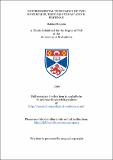Files in this item
Environmental physiology of two hoverflies, "Eristalis tenax" and "E. pertinax"
Item metadata
| dc.contributor.advisor | Willmer, Pat | |
| dc.contributor.author | Bressin, Sabine | |
| dc.coverage.spatial | 335 p. | en_US |
| dc.date.accessioned | 2018-07-04T13:56:32Z | |
| dc.date.available | 2018-07-04T13:56:32Z | |
| dc.date.issued | 1999 | |
| dc.identifier.uri | https://hdl.handle.net/10023/14924 | |
| dc.description.abstract | Eristalis tenax and E. pertinax are two closely related Scottish hoverflies that share various ecological features, such as feeding sources, but differ in others (e.g. only adult E. tenax overwinter). The physiological performances and behaviour of these flies were studied in relation to the hygrothermal constraints faced, as were the physiological adaptations in the two (summer and winter) generations of E. tenax. Their water loss rates are rather high, lying in the upper part of the range for mesic insects. Rates are higher in E. tenax than in E. pertinax, and higher in male than in female E. pertinax. Water loss rates can be modified, notably in overwintering, water stressed females. Because of the rather high levels of evaporative cooling, these flies equilibrate at a temperature lower than ambient temperature. This work supports Bakken's (1976) recommendation of using equilibrium temperature as the "external" temperature for the estimation of warming and cooling constants, and further analyses the effects of evaporative cooling on these constants. Both species have endothermic abilities. Only E. tenax thermoregulate to a moderate degree in forward flight, but hovering male E. pertinax are excellent thermoregulators. Haemolymph shunting appears to be in operation in E. tenax, but is unlikely to be a controlled process. Large flies exchange heat with the environment more slowly, have faster warm-up rates, and take off at (and fly with) higher thoracic temperatures than small ones. Both linear dimensions and mass have to be considered, as the various aspects of insects' biology are not affected by the same size factor and because only then can "real" sex differences be distinguished from ones resulting from a difference in shape in males and females. In Scotland, male E. pertinax hover whereas male E. tenax do not. Hovering duration is strongly influenced by temperature. The foraging activity of these flies appears to be controlled in part by a circadian rhythm with additional effects of temperature in male E. tenax, and of light in E. pertinax. Overwintering female E. tenax select crevices in caves and ruins that offer a relatively constant, warm and highly humid microclimate. The start and end of overwintering appear to be triggered by changes in ambient temperature. Further opportunities for comparative studies of eristalines across their broad geographical range and between summer and winter generations are considered. | en_US |
| dc.language.iso | en | en_US |
| dc.publisher | University of St Andrews | |
| dc.subject.lcc | QL537.S9B8 | en |
| dc.subject.lcsh | Syrphidae | en |
| dc.title | Environmental physiology of two hoverflies, "Eristalis tenax" and "E. pertinax" | en_US |
| dc.type | Thesis | en_US |
| dc.type.qualificationlevel | Doctoral | en_US |
| dc.type.qualificationname | PhD Doctor of Philosophy | en_US |
| dc.publisher.institution | The University of St Andrews | en_US |
This item appears in the following Collection(s)
Items in the St Andrews Research Repository are protected by copyright, with all rights reserved, unless otherwise indicated.

